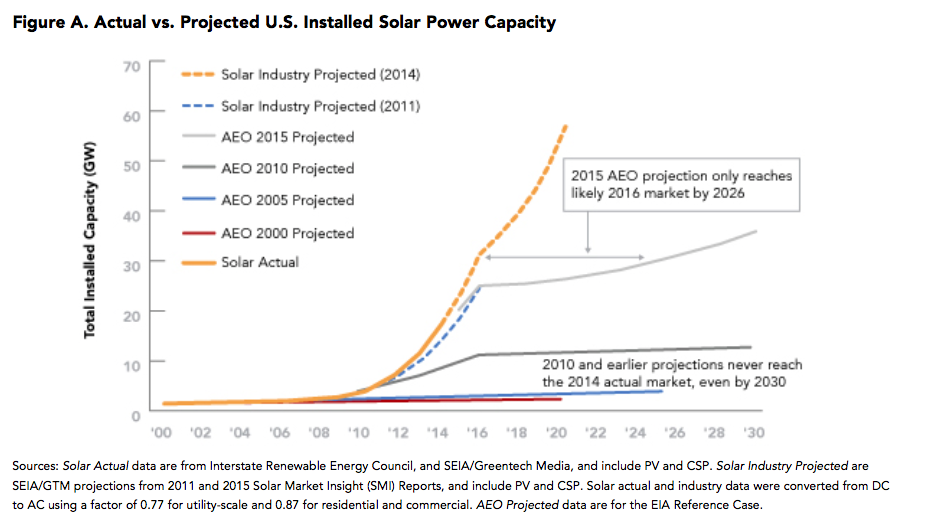
What are the differences between me and the Energy Information Administration (EIA)? This might be difficult, so I’ll give some hints: One of us is a government agency funded to the tune of $122  million and one of us is a Social Media Manager at AEE. One of us has an Administrator, a Deputy Administrator, four Assistant Administrators, and 16 connected offices tasked with collecting, analyzing, and disseminating independent and impartial energy information to promote sound policymaking, efficient markets, and public understanding of energy, and one of us has a mug with a panda on it (see photo). But the main difference between me and the EIA? I have no trouble admitting when I’m wrong. For EIA, on the other hand, a full-throated confession of error seems harder to come by.
million and one of us is a Social Media Manager at AEE. One of us has an Administrator, a Deputy Administrator, four Assistant Administrators, and 16 connected offices tasked with collecting, analyzing, and disseminating independent and impartial energy information to promote sound policymaking, efficient markets, and public understanding of energy, and one of us has a mug with a panda on it (see photo). But the main difference between me and the EIA? I have no trouble admitting when I’m wrong. For EIA, on the other hand, a full-throated confession of error seems harder to come by.
A few weeks ago, I wrote a piece entitled Merger Madness: The Mega-Utility Stalls Out, in which I described three different utility mergers in D.C., Texas, and Louisiana, that had run into seemingly insurmountable regulatory barriers. It turns out I was wrong, like, really wrong: D.C. and Texas both worked to finalize the mergers last week, and this week we got news that the third merger had been approved. A group of investors from Australia and Canada, led by Macquarie Infrastructure and Real Assets and British Columbia Investment Management Corporation (from Australia and Canada, respectively), this week finalized a deal to buy Cleco Corporation, a Louisiana utility serving more than 250,000 customers.
I was wrong about utility mergers. There – I said it, straight out, no hedging. I’ll be on the lookout for some place in D.C. that serves crow for takeout.
Now, this week, EIA admitted that it, too, was wrong, at least sort of.
The agency released “Wind and Solar Data and Projections from the U.S. Energy Information Administration: Past Performance and Ongoing Enhancements,” in which EIA grapples with claims from many critics, including us (see below), that it gets its numbers wrong, when it comes to projecting the future growth of renewable energy installations, in particular.
In this self-assessment, EIA fesses up to some failings, and promises to do better. But the self-critique ends up being, as David Roberts at Vox wrote, “something between a mea culpa and a defense of its work,” with “the tone of the report and some of its assertions [striking] many people as defensive and a little bit prickly.” Though noting some “valuable insights” in EIA’s self-assessment, energy researcher Alex Gilbert observed, in a series of tweets, that “the rest of the analysis primarily consists of cherrypicking data to paint @EIAgov in the most positive light.”
What’s wrong with EIA’s work? In short, the agency consistently and repeatedly underestimates the growth and economic impact of advanced energy. Just take a look at this graph:

And it’s not just solar. EIA is consistently wrong about the wind market, as well as several other advanced energy technologies. Even with the understanding that the EIA is bound by its mission to not prescribe policy solutions, it makes faulty assumptions that, with remarkable consistency, make the prospects for advanced energy growth appear more dim than they turn out to be.
Last June, AEE Institute released a report showing that renewable energy and energy efficiency are competitive in today’s markets. That report also critiqued EIA’s faulty (and always in one direction) projections. “[EIA’s] forecasts are consistently off by a wide margin, always underestimating – and never overestimating – future deployment of renewables. Such persistent inaccuracy is indicative of a more fundamental problem in understanding the dynamics of growth for these technologies, as well as constraints on how the EIA is required to conduct its modeling.” This week’s EIA report is, in part, a direct response, with EIA citing AEE Institute’s paper several times.
Projecting the future is hard (obviously), but, as Politico’s Michael Grunwald pointed out, this “isn’t just some random pundit.” The EIA has “tremendous influence in Washington and state capitals.” The weight they put behind these numbers matters, and the agency’s role as impartial data collector and reporter is significant and important. Hopefully, this report indicates a new direction for the agency – one that reflects market reality. Or, as Roberts puts it, “EIA's self-reflective report on past projections is a good start. Now it just needs to relax a little, get a little less defensive, and keep the conversation going.”
Just how big is the advanced energy economy? Check out Advanced Energy Now 2016 Market Report, free from AEE. Click below to download.
